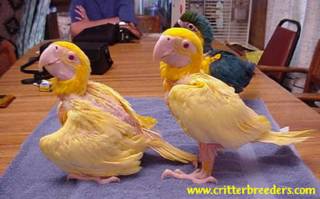Strange Genetic Wonders
Over the centuries, man has selectively bred many animals. Usually, this breeding is undertaken to increase the productivity, tractability, utility, or heartiness of the species. Rarely is it undertaken solely to increase diversity.

Not so with pet birds. In the past few decades, parrot coloration has exploded. Breakthroughs in the breeding of Budgies, Lovebirds, and Cockatiels have yielded literally hundreds of color variations in each of these species. When you are next at PetSmart or PetCo, take a look at the cage filled with Budgies and realize that each member of that rainbow of animated skittles was bred from the plain old green parakeet.
Until fairly recently, this color explosion has been limited to the smallest and fastest breeding species. The larger birds are harder to breed, lay smaller clutches, require much more space, and cost a great deal more per specimen. In the largest species, like Macaws and Cockatoos, sexual maturity may not happen until the bird is six to ten years of age, and even then pairs are sometimes incompatible for unknown reasons. In short, it is quite an investment in time and money to try to create new color strains.
The Macaws that most people are familiar with are like those above - the Blue and Gold and the Greenwing are among the most commonly available in the pet industry (along with the Scarlet). It has become increasingly common to put mixed pairs like the one above together to get hybrid Macaws, but these are not truly new color strains - they are more like mixed-breed dogs, in that they usually retain something of the physical characteristics of each parent. They may or may not breed true (which means their offspring may or may not look like them). Many bird breeders frown on hybridization, as most of these species are dwindling in the wild. Some day, captive birds may be the only examples of these incredible species that remain, and when/if that day arrives we will need pure bloodlines to preserve them.
Below, however, we have a legitimate color strain mutation.

These three-month-old baby Macaws are lutino mutations. The lutino was one of the first mutations to appear in Cockatiels, and it is believed to be the key to many other color possibilitites. The presence of lutino chicks indicates that the male of this breeding pair is a heterozygous "split" to lutino - meaning that the cock carries the sex-linked gene for lutino in the recessive state.

The other good news here is that, as shown above, they keep this coloring in their adult plummage!
Soon, we may be seeing other colors of Macaws. I personally want one that is plaid...
Update
I've since discovered that these birds were born in Texas. There was one female, but she died during a surgery to repair a broken leg. There are now 5 males, and they are all paired with normal color females at this point (the picture above is one such pair). They were originally hatched back in 2000, so they probably won't begin breeding for a while yet (B&Gs mature at around 8-10 years of age), but they have a lengthy reproductive lifespan (up until they are 35 or more) so it is possible that these birds could be the foundation of a new Lutino breeding line!
Subscribe to:
Post Comments (Atom)




0 comments:
Post a Comment